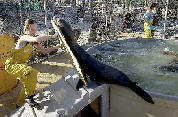|
Modern medical facilities for animals, in-ground pools and a new education centre are part of a multimillion-dollar revamp of the Marine Mammal Center that received key federal approval this week.
The U.S. Department of the Interior announced the $14.5 million project in the Marin Headlands near Fort Cronkhite complies with National Environmental Policy Act standards and can move forward.
"We are terrifically happy that our environmental approvals are in place and we are looking forward to groundbreaking Oct. 1 of 2005," said Pamela Westfall-Bochte, director of development at the centre.
The non-profit centre kicked off a public campaign two years ago and had raised $12.2 million of the $14.5 million needed for the capital improvements, which include upgrades to holding pools, an improved lab and a learning centre for visitors.
The existing facility is spread among five separate buildings, and the new construction will make better use of the space, Westfall-Bochte said.
"It's going to be better, not bigger," she said. "We are basically restructuring what is there to better service the animals and to ensure animal safety. There will also be a better education component for the public and a classroom for kids. Now they have to stand in the rain."
The projected cost could rise because of the increasing cost of steel and plastic, Westfall-Bochte said.
"The people of Marin have been great in giving and supporting this project," she said.
The Marin Community Foundation contributed $1 million early in the campaign toward construction of the Marine Science Community Education Center. Some 35,000 schoolchildren visit the site annually.
The new education centre is one aspect of what will be a significant upgrade of the aging facilities at the centre. Some of the buildings date to when the military was in the area from the 1940s through the early 1970s. Some offices are in old shipping containers.
Staying within its existing site, some building plans include:
|
